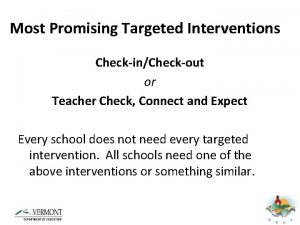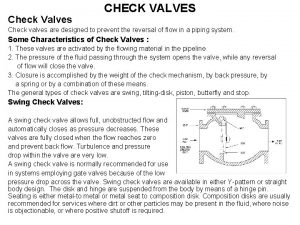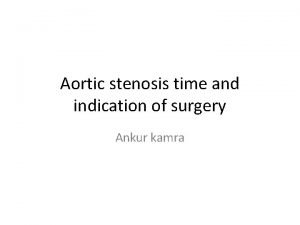Implementation of Clinical Indication for Dwell Time Check




















- Slides: 20

+ Implementation of Clinical Indication for Dwell Time: Check the Patient, Not the Clock Michelle De. Vries, MPH CIC Senior Infection Control Officer Methodist Hospitals, Gary, Indiana mdevries@methodisthospitals. org www. webbertraining. com Hosted by Paul Webber paul@webbertraining. com May 26, 2017

+ 2 Objectives n Review current recommendations regarding peripheral IV dwell time n Discuss framework for launching protected clinical indication as part of a comprehensive infection prevention program n Propose process and outcome surveillance measures to evaluate the success of interventions in the context of a hospital who has achieved success with this policy change

+ 3 CDC Recommendations n There is no need to replace peripheral catheters more frequently than every 72 -96 hours to reduce risk of infection and phlebitis in adults. Category 1 B n No recommendation is made regarding replacement of peripheral catheters in adults only when clinically indicated. Unresolved issue n Replace peripheral catheters in children only when clinically indicated. Category 1 B n Some studies have suggested that planned removal at 72 hours vs. removing as needed resulted in similar rates of phlebitis and catheter failure. However, these studies did not address the issue of CRBSI, and the risk of CRBSIs with this strategy is not well studied. http: //www. cdc. gov/hicpac/pdf/guidelines/bsi-guidelines-2011. pdf Accessed April 20, 2016

+ 4 INS Standards 2016 n Remove the short peripheral catheter if it is no longer included in the plan of care or has not been used for 24 hours of more n Remove short peripheral and midline catheters in pediatric and adult patients when clinically indicated, based on findings from site assessment and/or clinical signs and symptoms of systemic complications.

+ 5 INS Standards 2016 n Use the venous site most likely to last the full length of the prescribed therapy, using the forearm to increase dwell time, decrease pain during dwell time, promote self-care and prevention accidental removal and occlusions. n Use a new pair of disposable, nonsterile gloves in conjunction with a “no-touch” technique for peripheral IV insertion, meaning that the insertion site is not palpated after skin antisepsis n Dressing changes are performed… every 5 -7 days and immediately if the dressing integrity becomes damp, loosened, or visibly soiled, or if moisture, drained or blood are present under the dressing. n Consider increased attention to aseptic technique, including strict attention to skin antisepsis and the use of sterile gloves, when placing short peripheral catheters… contamination of nonsterile gloves is documented n Consider monitoring bloodstream infection rates for peripheral catheters, or vascular catheter associated infections (peripheral) regularly n Make no more than 2 attempts at short peripheral intravenous access per clinician, and limit total attempts to no more than 4 n Consider the use of maximal sterile barrier precautions with midline catheter insertion n For peripheral catheters, consider two options for catheter stabilization: (1) in integrated stabilization feature on the catheter hub combined with a bordered polyurethane securement dressing or (2) a standard round hub peripheral catheter in combination with an adhesive ESD.

+ 6 Framing the discussion… n Most commonly used invasive device in hospitals n Up to 70% of patients receive one at some point during their hospitalization n Device utilization estimation is 20 -30% of patient days n High failure rate reported n n Mean across studies is 46% 60% of first attempts are unsuccessful n 27% of patients endure 3 or more attempts

+ Maki DG et al. , Mayo Clinic Proc 2006; 81: 1159 -1171. 7

+ State HAI reporting in Pennsylvania n Hospitals are required to report ALL laboratory confirmed bloodstream infections (LCBI) n n In 2011 there were 2479 LCBI reported to the state n n n Not just CLABSI 1540 were CLABSI Which means 939 (38%) did not have a central line in place n How many of these may be related to peripheral lines? n What else could be contributing? n Several studies have shown around 20% of all LCBI may be from PVC The 2014 HAI report disclosed: n 2163 bloodstream infections n 1140 CLABSIs n This leaves 1023 with no central line (47%) 8

+ 9 Peripheral Venous Catheter-Related Staphylococcus aureus Bacteremia n 24 S. aureus bacteremias n 12% of all device related S. aureus bacteremias were caused by PVCs n Average treatment in this study was 19 days n Serious complications noted: n n Two patient deaths and one transfer to hospice Two I&D of local site One DVT from PICC line placed to treat PVC-BSI Ten events that would be reportable in to CMS (USA government mandate) under current regulations n 8 MRSA bacteremias n 2 C. diff

+ 10 More to the S. aureus story… n Further analysis of the Pennsylvania data n Included all non-central line related BSI from 2011 and 2012 n Based on pathogen analysis and infection onset, they speculate that “it is likely that the majority of acute care primary BSIs in Pennsylvania are due to PVCRI” n Additionally, they use S. aureus as an indicator for PVCRI and note that there is a substantial spike after 72 hours

+ Agency for Healthcare Research and Quality: Morbidity and Mortality Rounds on the Web n Case study of 75 year old man with history of CAD and CHF admitted for CHF exacerbation. n After PIV in for four days, RN requested orders to leave IV in an additional day or two because placement (given edema) would be difficult. n On day 6 patient developed erythema at the IV site and later that day developed fever and chills. n n Subsequently, patient complained of back pain. MRI of the spine revealed epidural abscess. n n Blood cultures grew MRSA. Aspiration grew MRSA Treatment required 6 weeks of antibiotics and is estimated to have cost hundreds of thousands of collars 11

+ 12 Bundling for success n Insertion: n CHG skin prep n Sterile gloves if repalpating the site n Alcohol caps for intraluminal protection n Chlorhexidine impregnated sponge dressing for extraluminal protection n Updated catheter – integrated extension set n Integrated securement dressing n Neutral connectors n Maintenance: n Careful assessment – check the patient, not the box n Remove when clinically indicated, with dressing change at 7 days (or sooner if dressing compromised) n Re-prep when redressing the site n Ongoing surveillance of process and outcomes n Review any infections with floor staff in “real time” to discuss missed opportunities for prevention

+ 13 What does the data show? After 12 months of clinical indication policy: n 38% statistically significant reduction in primary bacteremia (sustained at 24 months) n 19% reduction in PIV associated bloodstream infections (with 6% further reduction at 24 months) n n 35% of PIVs now lasting more than 5 days Average dwell time 4. 2 days n 48% decrease in IV start kits n 75% decrease in ICU CLABSI (sustained at 24 months) n 24% increase in patient satisfaction scores for patients hospitalized at least 5 days

+ 14 It’s not just about infections… n Fewer sticks by reducing arbitrary restarts can impact 1: n Patient satisfaction n Vessel preservation n Supply costs n Nursing time n Expanding interventions beyond just central lines *may* also benefit CLABSI rates 2 n Anyway you look at it, making an investment in safely implementing an approach to address peripheral IVs there is much to be gained

+ 15 What about midlines? n In an effort to reduce CLABSI incidence many hospitals are looking increasingly to midline catheters as part of their solution. n Midlines are considered peripheral catheters per INS standards and CDC definitions regarding tip termination. n How are you protecting your patients with these lines? n n n Insertion? INS says consider maximum sterile barriers. Protection? These lines may dwell for up to 29 days How are you measuring success? n n Decrease in central line days? Decrease in CLABSI? Material costs and time savings? Incidence of Midline associated bloodstream infection?

+ 16 Planning for safety n Engaging all involved disciplines in the development of a new policy for extending dwell time n Addressing any product changes to assist with objectives of increased dwell time n Reviewing staff training/competencies n Understanding measures of success n Process measures n Outcome measures

+ 17 Knowing your own data… n How do you know it’s not a problem if you aren’t looking? n NHSN definitions are for laboratory confirmed bloodstream infections n n n Process data is as important as outcome data n n “Become” Central line associated (CLABSI) by the presence of a central line Same reasoning can be applied BSI with no source other than Peripheral venous access Take advantage of value added offerings from vendors to help leverage your data Consider product and practice interventions for all intravascular devices, not just central lines.

+ June 2 ARE YOUR CLEANING WIPES SAFE? EVIDENCE SUPPORTING THE “ONE ROOM – ONE WIPE” APPROACH IN HEALTHCARE SETTINGS Dr. Laura Gavaldà, Hospital Universitari de Bellbitge, Barcelona, Spain June 9 CONTROLLING THE SPREAD OF VRE: IS ACTIVE SURVEILLANCE WORTHWHILE? Prof. Hilary Humphreys, Royal College of Surgeons in Ireland June 13 (FREE Teleclass - Broadcast live from the 2016 APIC conference) BRIDGING THE GAP BETWEEN RESEARCH AND PRACTICE IN LONGTERM CARE: AN INNOVATIVE MODEL FOR SUCCESS Sharon Bradley, Pennsylvania Patient Safety Authority June 13 (FREE Teleclass - Broadcast live from the 2016 APIC conference) BEING HEARD: THE INFECTION PREVENTIONIST AND THE ORGANIZATIONAL STRUCTURE Sharon Glowicz, Texas Health Resources, Presbyterian Hospital of Denton, Texas


 Kps
Kps Maximum unambiguous range
Maximum unambiguous range Piston dwell
Piston dwell Dwell in ignorance meaning
Dwell in ignorance meaning Emily dickinson i dwell in possibility analysis
Emily dickinson i dwell in possibility analysis Evste
Evste God does not dwell in temples made with hands
God does not dwell in temples made with hands Dwell on these things
Dwell on these things Behavior check in check out sheet
Behavior check in check out sheet Behavior check in check out sheet
Behavior check in check out sheet Check in check out
Check in check out Check in check out system
Check in check out system Jobbank
Jobbank Dda algorithm advantages and disadvantages
Dda algorithm advantages and disadvantages Check in check out pbis
Check in check out pbis Check in check out intervention
Check in check out intervention Collision forces quick check
Collision forces quick check Chapter 5 cash control systems answer key
Chapter 5 cash control systems answer key Check your progress 1
Check your progress 1 What is elapsed time
What is elapsed time Kontinuitetshantering
Kontinuitetshantering






































